[English] 日本語
 Yorodumi
Yorodumi- PDB-1qvo: STRUCTURES OF HLA-A*1101 IN COMPLEX WITH IMMUNODOMINANT NONAMER A... -
+ Open data
Open data
- Basic information
Basic information
| Entry | Database: PDB / ID: 1qvo | ||||||
|---|---|---|---|---|---|---|---|
| Title | STRUCTURES OF HLA-A*1101 IN COMPLEX WITH IMMUNODOMINANT NONAMER AND DECAMER HIV-1 EPITOPES CLEARLY REVEAL THE PRESENCE OF A MIDDLE ANCHOR RESIDUE | ||||||
 Components Components |
| ||||||
 Keywords Keywords | IMMUNE SYSTEM | ||||||
| Function / homology |  Function and homology information Function and homology informationsymbiont-mediated suppression of host antigen processing and presentation of peptide antigen via MHC class I / symbiont-mediated suppression of host antigen processing and presentation of peptide antigen via MHC class II / symbiont-mediated suppression of host autophagy / positive regulation of memory T cell activation / T cell mediated cytotoxicity directed against tumor cell target / TAP complex binding / Golgi medial cisterna / positive regulation of CD8-positive, alpha-beta T cell activation / CD8-positive, alpha-beta T cell activation / positive regulation of CD8-positive, alpha-beta T cell proliferation ...symbiont-mediated suppression of host antigen processing and presentation of peptide antigen via MHC class I / symbiont-mediated suppression of host antigen processing and presentation of peptide antigen via MHC class II / symbiont-mediated suppression of host autophagy / positive regulation of memory T cell activation / T cell mediated cytotoxicity directed against tumor cell target / TAP complex binding / Golgi medial cisterna / positive regulation of CD8-positive, alpha-beta T cell activation / CD8-positive, alpha-beta T cell activation / positive regulation of CD8-positive, alpha-beta T cell proliferation / CD8 receptor binding / antigen processing and presentation of exogenous peptide antigen via MHC class I / beta-2-microglobulin binding / endoplasmic reticulum exit site / TAP binding / antigen processing and presentation of endogenous peptide antigen via MHC class I via ER pathway, TAP-dependent / protection from natural killer cell mediated cytotoxicity / host cell Golgi membrane / antigen processing and presentation of endogenous peptide antigen via MHC class I via ER pathway, TAP-independent / antigen processing and presentation of endogenous peptide antigen via MHC class Ib / detection of bacterium / T cell receptor binding / negative regulation of receptor binding / early endosome lumen / Nef mediated downregulation of MHC class I complex cell surface expression / DAP12 interactions / transferrin transport / cellular response to iron ion / Endosomal/Vacuolar pathway / lumenal side of endoplasmic reticulum membrane / Antigen Presentation: Folding, assembly and peptide loading of class I MHC / peptide antigen assembly with MHC class II protein complex / cellular response to iron(III) ion / MHC class II protein complex / negative regulation of forebrain neuron differentiation / antigen processing and presentation of exogenous protein antigen via MHC class Ib, TAP-dependent / ER to Golgi transport vesicle membrane / peptide antigen assembly with MHC class I protein complex / regulation of iron ion transport / regulation of erythrocyte differentiation / HFE-transferrin receptor complex / response to molecule of bacterial origin / MHC class I peptide loading complex / T cell mediated cytotoxicity / positive regulation of T cell cytokine production / antigen processing and presentation of endogenous peptide antigen via MHC class I / antigen processing and presentation of exogenous peptide antigen via MHC class II / positive regulation of immune response / MHC class I protein complex / positive regulation of T cell activation / peptide antigen binding / positive regulation of receptor-mediated endocytosis / negative regulation of neurogenesis / cellular response to nicotine / SH3 domain binding / positive regulation of T cell mediated cytotoxicity / multicellular organismal-level iron ion homeostasis / virion component / specific granule lumen / positive regulation of type II interferon production / phagocytic vesicle membrane / recycling endosome membrane / Interferon gamma signaling / Immunoregulatory interactions between a Lymphoid and a non-Lymphoid cell / negative regulation of epithelial cell proliferation / MHC class II protein complex binding / Interferon alpha/beta signaling / Modulation by Mtb of host immune system / late endosome membrane / sensory perception of smell / antibacterial humoral response / positive regulation of cellular senescence / tertiary granule lumen / DAP12 signaling / T cell differentiation in thymus / T cell receptor signaling pathway / E3 ubiquitin ligases ubiquitinate target proteins / negative regulation of neuron projection development / ER-Phagosome pathway / protein refolding / early endosome membrane / protein homotetramerization / amyloid fibril formation / intracellular iron ion homeostasis / learning or memory / defense response to Gram-positive bacterium / immune response / endoplasmic reticulum lumen / Amyloid fiber formation / signaling receptor binding / Golgi membrane / lysosomal membrane / innate immune response / external side of plasma membrane / focal adhesion / Neutrophil degranulation / endoplasmic reticulum membrane / GTP binding / SARS-CoV-2 activates/modulates innate and adaptive immune responses / host cell plasma membrane Similarity search - Function | ||||||
| Biological species |  Homo sapiens (human) Homo sapiens (human)  Human immunodeficiency virus 1 Human immunodeficiency virus 1 | ||||||
| Method |  X-RAY DIFFRACTION / X-RAY DIFFRACTION /  MOLECULAR REPLACEMENT / Resolution: 2.22 Å MOLECULAR REPLACEMENT / Resolution: 2.22 Å | ||||||
 Authors Authors | Li, L. / McNicholl, J.M. / Bouvier, M. | ||||||
 Citation Citation |  Journal: J.Immunol. / Year: 2004 Journal: J.Immunol. / Year: 2004Title: Structures of HLA-A*1101 complexed with immunodominant nonamer and decamer HIV-1 epitopes clearly reveal the presence of a middle, secondary anchor residue. Authors: Li, L. / Bouvier, M. #1:  Journal: Acta Crystallogr.,Sect.D / Year: 2002 Journal: Acta Crystallogr.,Sect.D / Year: 2002Title: Crystallization and preliminary X-ray crystallographic studies of HLA-A*1101 complexed with an HIV-1 decapeptide Authors: Li, L. / Promadej, N. / McNicholl, J.M. / Bouvier, M. | ||||||
| History |
|
- Structure visualization
Structure visualization
| Structure viewer | Molecule:  Molmil Molmil Jmol/JSmol Jmol/JSmol |
|---|
- Downloads & links
Downloads & links
- Download
Download
| PDBx/mmCIF format |  1qvo.cif.gz 1qvo.cif.gz | 174 KB | Display |  PDBx/mmCIF format PDBx/mmCIF format |
|---|---|---|---|---|
| PDB format |  pdb1qvo.ent.gz pdb1qvo.ent.gz | 138.4 KB | Display |  PDB format PDB format |
| PDBx/mmJSON format |  1qvo.json.gz 1qvo.json.gz | Tree view |  PDBx/mmJSON format PDBx/mmJSON format | |
| Others |  Other downloads Other downloads |
-Validation report
| Arichive directory |  https://data.pdbj.org/pub/pdb/validation_reports/qv/1qvo https://data.pdbj.org/pub/pdb/validation_reports/qv/1qvo ftp://data.pdbj.org/pub/pdb/validation_reports/qv/1qvo ftp://data.pdbj.org/pub/pdb/validation_reports/qv/1qvo | HTTPS FTP |
|---|
-Related structure data
- Links
Links
- Assembly
Assembly
| Deposited unit | 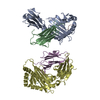
| ||||||||
|---|---|---|---|---|---|---|---|---|---|
| 1 | 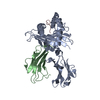
| ||||||||
| 2 | 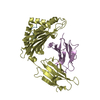
| ||||||||
| Unit cell |
|
- Components
Components
| #1: Protein | Mass: 31855.051 Da / Num. of mol.: 2 / Fragment: EXTRACELLULAR DOMAINS ALPHA 1,ALPHA 2 AND ALPHA 3 Source method: isolated from a genetically manipulated source Source: (gene. exp.)  Homo sapiens (human) / Description: from 1 major histocompatibility complex / Gene: HLA-A OR HLAA / Plasmid: PLM1 / Production host: Homo sapiens (human) / Description: from 1 major histocompatibility complex / Gene: HLA-A OR HLAA / Plasmid: PLM1 / Production host:  #2: Protein | Mass: 11879.356 Da / Num. of mol.: 2 Source method: isolated from a genetically manipulated source Source: (gene. exp.)  Homo sapiens (human) / Gene: B2M / Plasmid: PHN1 / Production host: Homo sapiens (human) / Gene: B2M / Plasmid: PHN1 / Production host:  #3: Protein/peptide | Mass: 1234.509 Da / Num. of mol.: 2 / Source method: obtained synthetically Details: THE PEPTIDE WAS OBTAINED THROUGH STANDARD SOLID-PHASE PEPTIDE SYNTHESIS. The sequence of the peptide is naturally found in Human Immunodeficiency Virus Type 1. Source: (synth.)   Human immunodeficiency virus 1 / References: UniProt: P04602 Human immunodeficiency virus 1 / References: UniProt: P04602#4: Water | ChemComp-HOH / | Has protein modification | Y | |
|---|
-Experimental details
-Experiment
| Experiment | Method:  X-RAY DIFFRACTION / Number of used crystals: 1 X-RAY DIFFRACTION / Number of used crystals: 1 |
|---|
- Sample preparation
Sample preparation
| Crystal | Density Matthews: 2.43 Å3/Da / Density % sol: 49.35 % |
|---|---|
| Crystal grow | Temperature: 293 K / Method: vapor diffusion, hanging drop / pH: 5.6 Details: PEG 4000, ammonium acetate, sodium citrate, pH 5.6, VAPOR DIFFUSION, HANGING DROP, temperature 293K |
-Data collection
| Diffraction | Mean temperature: 100 K |
|---|---|
| Diffraction source | Source:  ROTATING ANODE / Type: RIGAKU RU200 / Wavelength: 1.5418 Å ROTATING ANODE / Type: RIGAKU RU200 / Wavelength: 1.5418 Å |
| Detector | Type: SIEMENS HI-STAR / Detector: AREA DETECTOR / Date: Jun 14, 2001 |
| Radiation | Protocol: SINGLE WAVELENGTH / Monochromatic (M) / Laue (L): M / Scattering type: x-ray |
| Radiation wavelength | Wavelength: 1.5418 Å / Relative weight: 1 |
| Reflection | Resolution: 2.2→49.3 Å / Num. all: 43166 / Num. obs: 40704 / % possible obs: 94.3 % / Observed criterion σ(F): 0 / Observed criterion σ(I): 0 / Rsym value: 0.063 / Net I/σ(I): 10.6 |
| Reflection shell | Resolution: 2.22→2.34 Å / Mean I/σ(I) obs: 2.4 / % possible all: 51.3 |
- Processing
Processing
| Software |
| ||||||||||||||||||||||||||||||||||||
|---|---|---|---|---|---|---|---|---|---|---|---|---|---|---|---|---|---|---|---|---|---|---|---|---|---|---|---|---|---|---|---|---|---|---|---|---|---|
| Refinement | Method to determine structure:  MOLECULAR REPLACEMENT / Resolution: 2.22→49.3 Å / σ(F): 0 / σ(I): 0 / Stereochemistry target values: Engh & Huber MOLECULAR REPLACEMENT / Resolution: 2.22→49.3 Å / σ(F): 0 / σ(I): 0 / Stereochemistry target values: Engh & Huber
| ||||||||||||||||||||||||||||||||||||
| Solvent computation | Bsol: 53.0261 Å2 / ksol: 0.453517 e/Å3 | ||||||||||||||||||||||||||||||||||||
| Displacement parameters |
| ||||||||||||||||||||||||||||||||||||
| Refine analyze |
| ||||||||||||||||||||||||||||||||||||
| Refinement step | Cycle: LAST / Resolution: 2.22→49.3 Å
| ||||||||||||||||||||||||||||||||||||
| Refine LS restraints |
| ||||||||||||||||||||||||||||||||||||
| LS refinement shell | Resolution: 2.22→2.34 Å / Rfactor Rfree error: 0.025
|
 Movie
Movie Controller
Controller


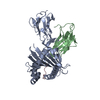

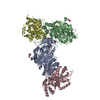






 PDBj
PDBj


